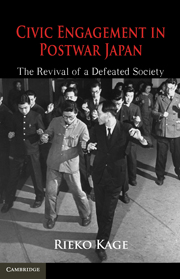Book contents
- Frontmatter
- Contents
- List of Tables
- List of Figures
- Preface
- Acknowledgments
- Civic Engagement in Postwar Japan
- 1 Introduction
- 2 Civic Engagement: The Dependent Variable
- 3 War and Civic Engagement: A Theoretical Framework
- 4 Quantitative Analysis: The Rise of Civic Engagement across Forty-Six Japanese Prefectures
- 5 The Long-Term Effects of Wartime Mobilization: Cross-National Analysis
- 6 Repression and Revival of the YMCA Japan
- 7 Wartime Endorsement and Postwar Repression of a Traditional Art
- 8 Civil Society and Reconstruction in Postwar Japan
- 9 Conclusions
- References
- Index
7 - Wartime Endorsement and Postwar Repression of a Traditional Art
Published online by Cambridge University Press: 06 December 2010
- Frontmatter
- Contents
- List of Tables
- List of Figures
- Preface
- Acknowledgments
- Civic Engagement in Postwar Japan
- 1 Introduction
- 2 Civic Engagement: The Dependent Variable
- 3 War and Civic Engagement: A Theoretical Framework
- 4 Quantitative Analysis: The Rise of Civic Engagement across Forty-Six Japanese Prefectures
- 5 The Long-Term Effects of Wartime Mobilization: Cross-National Analysis
- 6 Repression and Revival of the YMCA Japan
- 7 Wartime Endorsement and Postwar Repression of a Traditional Art
- 8 Civil Society and Reconstruction in Postwar Japan
- 9 Conclusions
- References
- Index
Summary
OVERVIEW
This chapter continues to process-trace the mechanisms through which prewar legacies of participation and wartime mobilization shape the growth of postwar civic engagement. In particular, it compares the postwar revival of participation in judo in the two cities of Fukuoka and Yokohama. Judo offers a useful contrast with the YMCA that was the focus of the previous chapter. Whereas the YMCA was repressed by the Japanese government during the war due to its Western origins but then was subsequently viewed favorably by the U.S. occupation for the same reason, judo, with its more “indigenous” origins, was favored by the militarist regime during World War II but then was actively discouraged by the U.S. occupation forces, as they believed it propagated militaristic values. Despite this adverse political climate, participation in judo grew during the postwar period across Japan, albeit at a slower rate than the YMCA (see Chapter 2, Figure 2.6). The number of new members rose every year, from 3,033 in 1946, to 4,301 in 1947, to 6,550 in 1948, to 8,103 in 1949. The fact that judo grew at all during this period highlights the strong bottom-up impetus for growth in civic engagement in Japan in the immediate postwar period; while occupation policies may have had some effect in discouraging this growth, they were not able to quench it. As this chapter will demonstrate, a major source of this bottom-up surge in participation was wartime mobilization.
- Type
- Chapter
- Information
- Civic Engagement in Postwar JapanThe Revival of a Defeated Society, pp. 123 - 139Publisher: Cambridge University PressPrint publication year: 2010



